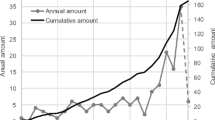Abstract
Traditionally, the risk priority number (RPN) is used to compute the failure risk by multiplying occurrence, detection, and severity factors. Claiming that the key feature of multiplying the three factors together to get the RPN is a limitation of this method, existing studies have developed the multiple criteria decision making (MCDM) approach. In this paper, we first show that the multiplication of the three factors is indeed useful not only for evaluating the failure risk based on the trade-off between the improvement cost and risk reduction but also for identifying an appropriate action to reduce the risk of a fixed failure only if failure data is available for evaluating each of the three factors. We then develop a modified method to use the well-established multiplication operation even when each factor is evaluated by an expert. A numerical example is presented to illustrate the advantage of the modified method over the previous MCDM approach in determining the effectiveness of action plans for system risk reduction when only qualitative data is available.







Similar content being viewed by others
References
Bian, T., Zheng, H., Yin, L., & Deng, Y. (2018). Failure mode and effects analysis based on D numbers and TOPSIS. Quality and Reliability Engineering International, 34, 501–515.
Carmignani, G. (2009). An integrated structural framework to cost-based FMECA: the priority-cost FMECA. Reliability Engineering and System Safety, 94, 861–871.
Carpitella, S., Certa, A., Izquierdo, J., & La Fata, C. M. (2018). A combined multi-criteria approach to support FMECA analyses: a real world case. Reliability Engineering and System Safety., 169, 394–402.
Chang, C.-L., Liu, P.-H., & Wei, C.-C. (2001). Failure mode and effects analysis using grey theory. Integrated Manufacturing Systems, 12, 211–216.
Department of the Army (2006). TM 5-698-4. FMECA for Command, Control, Communications, Computer, Intelligence, Surveillance, and Reconnaissance Facilities. United States Department of the Army.
Ford Motor Company. (1988). Potential Failure Mode and Effects Analysis. Dearborn, MI: Ford Motor Company.
Gilchrist, W. (1993). Modelling failure modes and effects analysis. International Journal of Quality and Reliability Management, 10, 16–23.
ISO/IEC Guide 51 (1999) Safety Aspects - Guidelines for Their Inclusion in Standards.
Kim, K. O., & Zuo, M. (2018a). Optimal allocation of reliability improvement target based on the failure risk and improvement cost. Reliability Engineering and System Safety, 180, 104–110.
Kim, K. O., & Zuo, M. (2018b). General model for the risk priority number in failure mode and effects analysis. Reliability Engineering and System Safety, 169, 321–329.
Kim, K. O. (2013). Effects of manufacturing defects on the device failure rate. Journal of the Korean Statistical Society, 42, 481–495.
Lee, W., Park, S. C., & Ahn, J. Y. (2019). Investigating dependence between frequency and severity via simple generalized linear models. Journal of the Korean Statistical Society, 48, 13–28.
Liu, H.-C., Chen, X.-O., Duan, C.-Y., & Wang, Y.-M. (2019a). Failure mode and effect analysis using multiple criteria decision making methods: a systematic literature review. Computers and Industrial Engineering, 135, 881–897.
Liu, H.-C., You, J. X., Chen, S., & Chen, Y. Z. (2016). An integrated FMEA approach for accurate risk assessment under uncertainty. IIE Transactions, 48, 1027–1042.
Liu, H.-C., Wang, L. N., Li, Z., & Hu, Y. P. (2019b). Improving risk evaluation in FMEA with cloud model and hierarchical TOPSIS method. IEEE Transactions on Fuzzy Systems, 27, 84–95.
Liu, H.-C., Li, Z., Song, W., & Su, Q. (2017). Failure mode and effect analysis using cloud model theory and PROMETHEE method. IEEE Transactions on Reliability, 66, 1058–1072.
Stamatis, D. H. (2013). Failure Mode and Effect Analysis: FMEA from Theory to Execution. Milaukee, WI: ASQC Quality Presss.
Wang, Y.-M., Chin, K.-S., Poon, G. K. K., & Yang, J.-B. (2009). Risk evaluation in FMEA using fuzzy weighted geometric mean. Expert Systems with Applications, 36, 1195–1207.
Yoon, K. P., & Hwang, C.-L. (1995). Multiple Attribute Decision Making, Sage Univerity Paper Series on Quantitative Applications in the Social Sciences. Thousand Oaks, CA: Sage.
Acknowledgements
This paper was supported by Konkuk University in 2018.
Author information
Authors and Affiliations
Corresponding author
Additional information
Publisher's Note
Springer Nature remains neutral with regard to jurisdictional claims in published maps and institutional affiliations.
Rights and permissions
About this article
Cite this article
Kim, K.O., Zuo, M.J. Evaluating the failure risk with and without failure data. J. Korean Stat. Soc. 51, 109–126 (2022). https://doi.org/10.1007/s42952-021-00126-4
Received:
Accepted:
Published:
Issue Date:
DOI: https://doi.org/10.1007/s42952-021-00126-4




